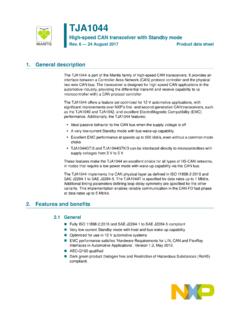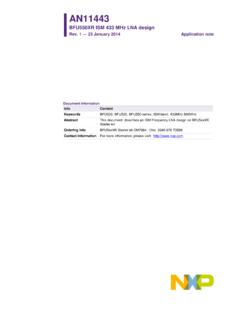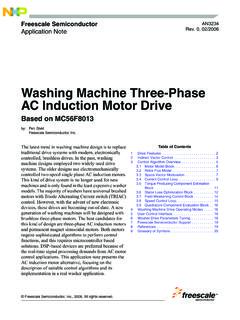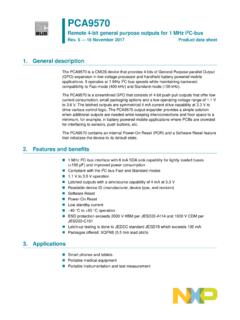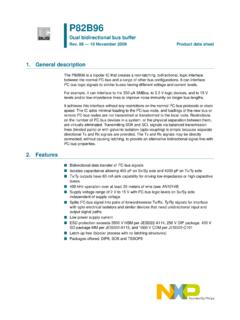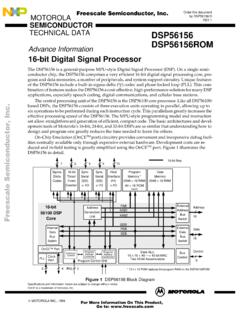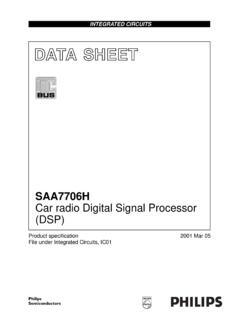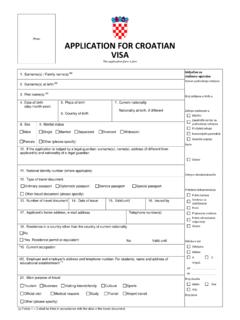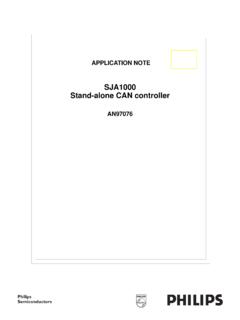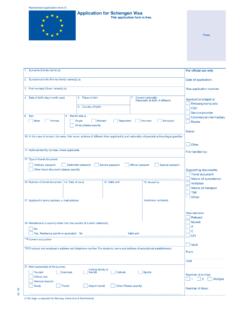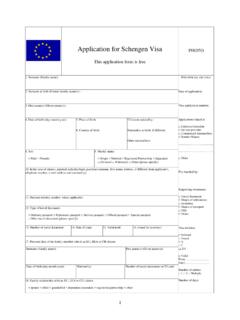Transcription of MIPI–CSI2 Peripheral on i.MX6 MPUs
1 2016 NXP MIPI csi2 Peripheral on MPUs 1. Introduction Purpose The purpose of this application note is to provide detailed information about the MIPI csi2 Peripheral on the family of processors with a usage example and details. Scope This application note applies to these processors: ( ) ( ) ( ) ( ) ( ) ( ) These devices are referred to by their abbreviated names throughout this document (shown above in parentheses). NXP Semiconductors Document Number: AN5305 Application Note Rev. 0 , 07/2016 Contents 1. Introduction .. 1 2. Overview .. 2 3. MIPI Camera Serial Interface Host Controller and D-PHY Configuration Details .. 10 4. CSI-2/IPU Gasket Configuration Details .. 16 5. IPU and CSI-2 Configuration Details .. 17 6. Usage Example .. 20 7. Appendix A MIPI- csi2 and D-PHY Registers .. 24 8. Revision History .. 31 Overview MIPI csi2 Peripheral on MPUs, Application Note, Rev.
2 0, 07/2016 2 NXP Semiconductors Audience This document is intended for those who: Need more information about the MIPI- csi2 Peripheral and its usage. Need to implement or debug a driver to capture still or moving images by the family processors using the MIPI- csi2 interface. Definitions, Acronyms, and Abbreviations The definitions of the terms and acronyms used in this document are: IPU image processing unit CSI camera sensor interface MIPI mobile industry processor interface (a global organization that develops interface specifications for the mobile ecosystem including mobile-influenced industries) D-PHY one of the physical-layer interfaces developed by MIPI ; designed to interface cameras and displays with low-power differential signals References reference manuals datasheets Chip Errata for the 6 Dual/6 Quad and 6 DualPlus/6 QuadPlus (document IMX6 DQCE) MIPI Alliance Standard for Camera Serial Interface 2 ( csi2 ) MIPI Board Approved 11/29/2005 MIPI Alliance Specification for Camera Serial Interface 2 (CSI-2) 2.
3 Overview The MIPI block has four data lanes (four differential pairs) on , , and , two data lanes on and , and one clock differential pair in all processors. Overview MIPI csi2 Peripheral on MPUs, Application Note, Rev. 0, 07/2016 NXP Semiconductors 3 Figure 1. lanes The number of lanes determines the bandwidth of the MIPI bus. Each lane can transfer up to 1000 Mb/s or up to 800 Mb/s when all four lanes are used. For more details, see Section Bandwidth . The I2C bus is required to configure most of the camera sensors. Routing MIPI stream into CSI-2 The processors have one MIPI/CSI-2 input and two parallel input interfaces (parallel 0 and parallel 1; see Figure 2). The streams in the MIPI format pass through the MIPI/CSI receiver, the CSI/IPU gasket, and a mux. On the ICs that have two IPUs, up to four streams can be received on the same MIPI bus. The CSI/IPU gasket can receive up to four different streams with different VCs (virtual channels) and route each stream to a specific CSI port (see Figure 2 and Figure 3).
4 Each CSI port has a specific virtual channel number and this configuration can t be changed. For example, for , VC0 is assigned to CSI0/IPU1, VC1 is assigned to CSI1/IPU1, and so on. Figure 2. Input video routing for , , and Overview MIPI csi2 Peripheral on MPUs, Application Note, Rev. 0, 07/2016 4 NXP Semiconductors Figure 3. Input video routing for and MIPI signal CSI-2 uses the MIPI standard for the D-PHY physical layer. This document provides an overview of the MIPI signal format. For more information about the MIPI specification, see MIPI Alliance Standard for Camera Serial Interface 2 documentation at Lanes CSI-2 is a lane-scalable specification. The applications that require more bandwidth than what is provided by one data lane or those trying to avoid high clock rates can expand the data path to two, three, or four lanes and obtain approximately linear increases in the peak bus bandwidth.
5 The data stream is distributed between the lanes. This figure shows an example of a 4-lane transmission: Figure 4. 4-lane data stream Low-level protocol (LLP) LLP is a byte-oriented, packet-based protocol which supports the transport of arbitrary data using the short and long packet formats. Overview MIPI csi2 Peripheral on MPUs, Application Note, Rev. 0, 07/2016 NXP Semiconductors 5 Two packet structures are defined for the LLP communication: long packets and short packets. For each packet structure, the exit from the low-power state followed by the start of transmission (SoT) sequence indicates the start of a packet. The end of transmission (EoT) sequence followed by the low-power state indicates the end of a packet. LLP features: Transport of arbitrary data (payload-independent) 8-bit word size Support for up to four interleaved virtual channels on the same link Special packets for the frame start, frame end, line start, and line end information Descriptor for the type, pixel depth, and format of the application-specific payload data 16-bit checksum code for error detection Figure 5.
6 LLP format In the above figure, PH represents the packet header and PF represents the packet footer. Long packets The following figure shows the structure of the LLP long packet. The long packet is identified by data types ranging from 0x10 to 0x37. See Table 1 for a description of data types. The long packet consists of three elements: a 32-bit packet header, an application-specific data payload with a variable number of 8-bit data words, and a 16-bit packet footer. The packet header is further composed of three elements: an 8-bit data identifier, a 16-bit word count field, and an 8-bit ECC. The packet footer has one element (a 16-bit checksum). Figure 6. LLP long packet structure Packet header = Data ID + Word count + ECC Packet footer = 16-bit checksum In Figure 6: LPS low-power state SoT start of transmission Overview MIPI csi2 Peripheral on MPUs, Application Note, Rev. 0, 07/2016 6 NXP Semiconductors Data ID contains the virtual channel identifier and the data type information WC word count the receiver uses the WC value to determine the end of the packet ECC 8-bit ECC code for the packet header Data application-specific payload EoT end of transmission Short packets The following figure shows the structure of the LLP short packet.
7 The short packet must be identified by data types ranging from 0x00 to 0x0F. See Table 1 for a description of data types. The short packet must contain only the packet header; the packet footer must not be present. The word-count field in the packet header must be replaced by the short-packet data field. For frame synchronization data types, the short-packet data field must be the frame number. For the line synchronization data types, the short-packet data field must be the line number. See Table 1 for a description of the frame and line synchronization data types. For the generic short-packet data types, the content of the short-packet data field must be user-defined. The error correction code (ECC) byte allows for the single-bit errors to be corrected and for the 2-bit errors to be detected in the short packet. Figure 7. LLP short packet structure Data identifier and virtual channel The data identifier byte contains the virtual channel identifier (VC) value and the data type (DT) value, as shown in Figure 8.
8 The virtual channel identifier is contained in two MS bits of the data-identifier byte. The data type value is contained in six LS bits of the data-identifier byte. The purpose of the virtual channel identifier is to provide separate channels for different data flows that are interleaved in the data stream. The virtual channel identifier number is in the top two bits of the data-identifier byte. The receiver monitors the virtual channel identifier and de-multiplexes the interleaved video streams to their appropriate channel. A maximum of four data streams is supported; the valid channel identifiers range from 0 to 3. The virtual channel identifiers in the peripherals must be programmable to enable the host processor to control how the data streams are de-multiplexed. Overview MIPI csi2 Peripheral on MPUs, Application Note, Rev. 0, 07/2016 NXP Semiconductors 7 Figure 8. Data identifier byte structure Data type The data type value specifies the format and content of the payload data.
9 A maximum of 64 data types is supported. There are eight different data type classes, as shown in the following table. Within each class, there are up to eight different data type definitions. The first two classes denote the short-packet data types. The remaining six classes denote the long-packet data types. Table 1. Data type classes Data type Description 0x00 0x07 Synchronization short-packet data types 0x08 0x0F Generic short-packet data types 0x10 0x17 Generic long-packet data types 0x18 0x1F YUV data 0x20 0x27 RGB data 0x28 0x2F Raw data 0x30 0x37 User-defined byte-based data 0x38 0x3F Reserved For more information about the data types, see MIPI Alliance Specification for Camera Serial Interface 2 (CSI-2). Interleaved video data streams Multiple data streams with different formats can be transferred by the MIPI bus. Each video stream must have one virtual channel assigned, as shown in this figure: Figure 9.
10 Multiple color format data stream Overview MIPI csi2 Peripheral on MPUs, Application Note, Rev. 0, 07/2016 8 NXP Semiconductors MIPI capabilities This table lists the maximum data lanes, simultaneous streams, and bit rate for various devices: Table 2. MIPI configuration limits for family members Data lanes 4 4 2 Max. simultaneous streams 4 4 2 Max. bit rate 3200 Mb/s 3200 Mb/s 2000 Mb/s Bandwidth The MIPI operating frequency is set by selecting the MIPI- csi2 clock source on the CCM (clock controller module). See the CCM section in the reference manual. On , , , and , the operating frequency is MIPI_PIXEL_CLK and its value can be changed without interfering with the other blocks. On and , the MIPI- csi2 clock source is CCM_PIXEL_CLK and it is connected to the IPU clock. The maximum MIPI- csi2 frequency is 200 MHz. The required minimum operating frequency of the interface is calculated as: F = FH * FW * FPS * BI * DF Where: FH frame height (in pixels) FW frame width (in pixels) FPS frame rate (frames per second) DF data format; defines the number of cycles needed to send a single pixel BI blank interval; a 35 % ( ) overhead provides a safe estimate for the minimum frequency In case the video mode data is available, the minimum operating frequency can be also calculated as: F = TFH * TFW * FPS * DF where: TFH total frame height = front porch + vsync + back porch TFW total frame width = front porch + hsync + back porch FPS frame rate (frames per second) DF data format; defines the number of cycles needed to send a single pixel The number of cycles needed to send a single pixel depends on the interface and the data format.

